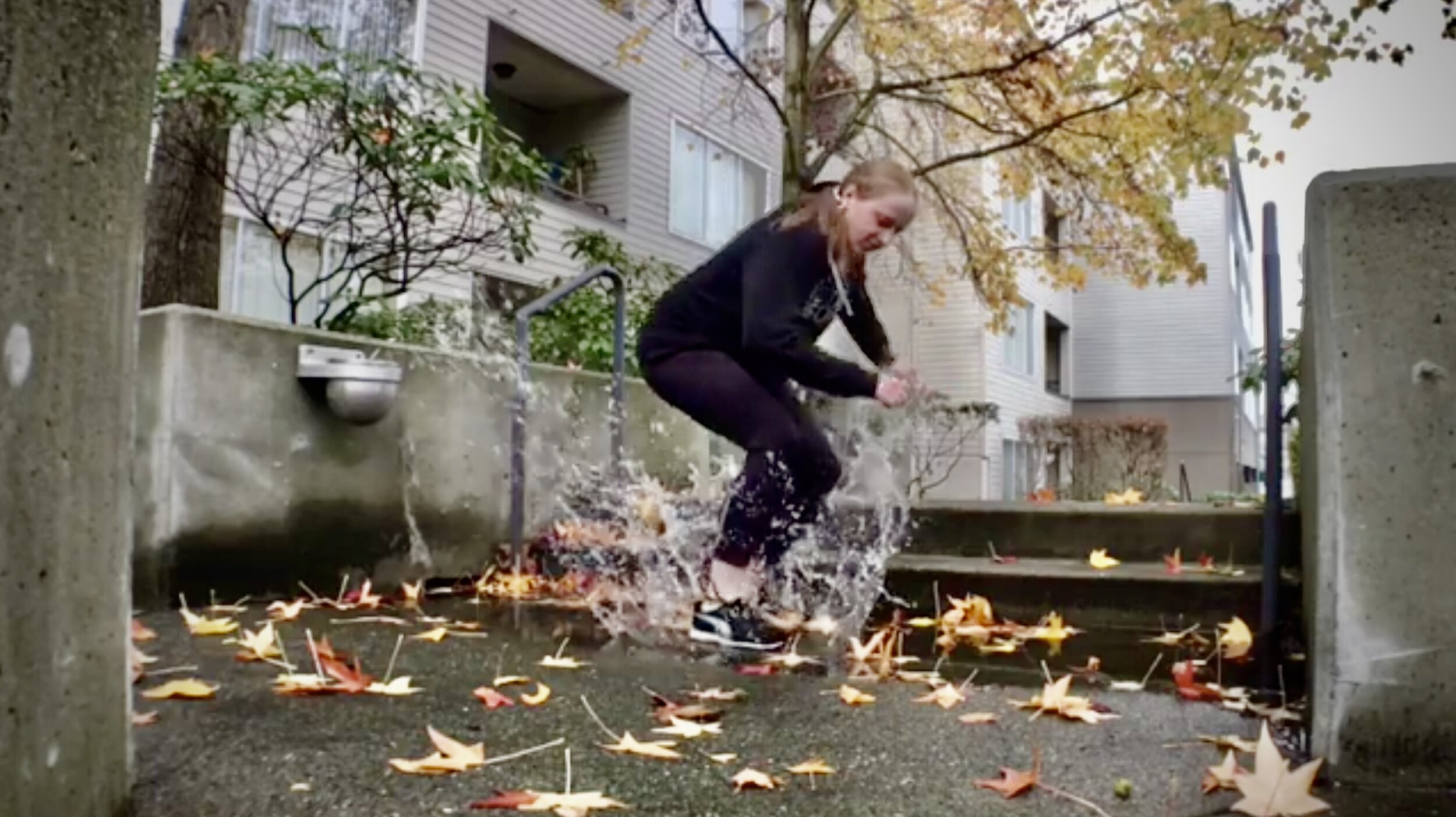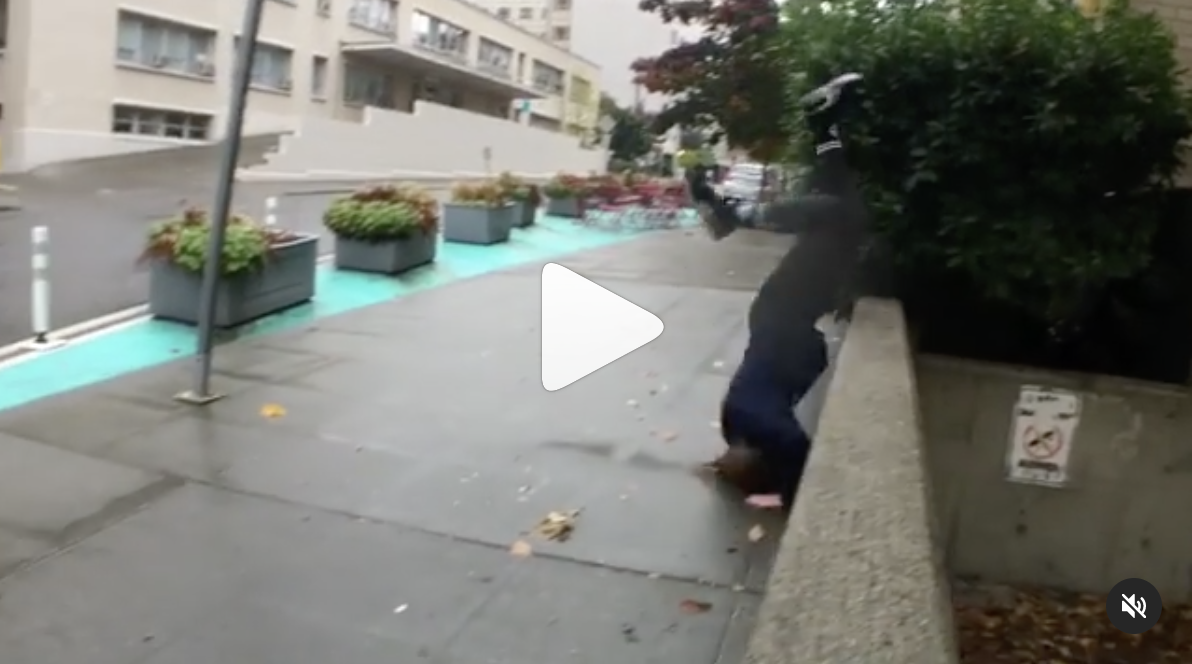Rain Training in Parkour: How and Why
Seattle parkour athlete Juliette Marzio side flips into a puddle.
In Seattle it rains a lot—152 days a year, in fact. Usually it’s a light, misty rain; rarely do we get downpours or thunderstorms. But the majority of November to March, it’s either raining or wet. If you wait for perfect training conditions, you’ll be waiting a long time. Meanwhile, your skills, creativity, and mental game will decline.
Train or shine, we say! As one of the rainiest cities in North America, we’d like to share our tips on parkour training in the rain.
Why Train In the Rain?
Getting outside is good for the soul. For many of us, training parkour is a crucial part of our health. Staying cooped up indoors saps your vital energy, especially in the darker months. And in a world with Covid-19, training outdoors is safer than training at a gym.
But there are other reasons to train parkour in the rain!
Training on wet surfaces provides new challenges. It’s well-known that limitations can spur creativity and innovation. Wet surfaces will feel new and different, and slippery surfaces will inspire you to be more precise.
My first winter of training parkour, I trained every Wednesday night on the dripping wet walls of Seattle’s Freeway Park. In the spring, I emerged a better, more confident parkour practitioner. And it made me appreciate our beautiful summers even more.
What to Wear
Clothing can make a huge difference in your comfort and willingness to train in the rain. Here are our tips:
Layer up! You may start out cold, but once you get moving, you’ll want to adjust how much clothing you’re wearing. Take off any heavy cotton layers before they get soaked.
Avoid cotton. It holds a lot of water, weighs you down, and sticks to your body. Synthetic fabrics tend to repel water better than cotton. Wool sheds water and retains its insulating properties, even when wet. You can also try waterproof or wool socks.
You can train in your regular shoes, or waterproof shoes if their soles are appropriate for parkour. Different soles will perform differently in wet conditions. Some might perform great; others will perform much worse. Always test your shoes. Test your grip on the ground before moving on to jumping!
Rain jackets are optional, since you can easily get too warm underneath. Vents can help. Make sure you can move in it.
If it’s warm enough, skip the gloves when training parkour. Gloves are good for warm-up and cool down, but they are less safe when using your hands, since your hands will move inside the gloves.
Pro tip: Bring dry clothes to put on afterward!
Other Things to Bring
We recommend a waterproof backpack for stashing your things. A towel is also nice to have so you can dry off surfaces. And hand warmers might help on colder days.
Where to Train
During the dry months, you may wish to scope out covered areas for some rain protection. Trees can provide some cover, especially if they are dense evergreens. If you’re anxious to get out of the house, a park shelter can provide rain protection if you’re willing to get creative in a minimalistic environment.
We don’t have many covered spots here in Seattle, so we quickly grow bored of them. However...
You can probably train at most of your normal spots when it’s raining. Some spots are better than others. For instance, at a favorite spot near my house, large puddles of water collect on the ground. Even a small covered area can make a big difference if it starts pouring.
Always check your surfaces! Just as soles perform differently, surfaces may perform differently when wet. Marble, brick, metal, wood, and mossy surfaces are notoriously slick when wet, but even some concrete can be slippery.
Even similar surfaces may perform differently. Test your shoes on each thing you want to jump on. Beware of stepping in water, as that makes your shoes wet, as well as any surface you step on.
And remember, wet rails are still great to practice balance on.
What to Train
After you’ve tested your surfaces, warm up with some basic jumps, QM, or drills. A good warm-up should not only make you physically warm, but it should focus your brain, inspire your curiosity, and generally tune in your mental game.
Conditioning is a good default for rainy days, according to senior instructor Brandee Laird. Drilling skills like balance, jumps, QM, and vaults can take the pressure off to perform. You can try creating a conditioning circuit so you have an achievable goal to reach for the session.
If you’re feeling curious and creative, create lines with flow and lowline movements. You might also find some interesting wet-surface challenges that are too easy when dry.
Don’t shy away from jumps, flips, and other more dynamic movements. Instead, adapt to the conditions in front of you. You can size down, change vaults and flips, whatever makes the movement challenging but still safe.
Lastly, make a plan before you go out to train. You’ll be more likely to leave the house, and more likely to train effectively.
Mental Game
So you’ve made your plan, picked a spot, tested your surfaces, and done your warm-up in the cold, wet weather. And now you want to go home. Right?
Wrong. Now is the time to up your mental game. Especially if you’re training with other people, do your part to keep the mood up. Here are some strategies I’ve used or observed others using in wet-weather training.
Make jokes about the weather. Be sarcastic. “What a beautiful day we’re having!” Brush up on your rain puns. “They say Portland is rainy… But Seattle is Rainier.”
Enjoy the struggle, whether solo or in a group. Commiserate, but keep going. Start together, finish together.
Build each other (and yourself) up. Acknowledge that you’re doing something hard. Honest compliments and affirmations go a long way when you’re on the verge of quitting.
Make it epic. You are a superior athlete! Nothing can stop you! Check out this video of David Ivey training in the rain and loving it.
Commit to getting wet and dirty. In our Beginner and Intermediate Freerunning classes, we train flips and acrobatics even when the grass and wood chips are wet. It’s fun to play like a child.
Engage your curiosity and creativity. How else can you navigate that space? What are these feelings about? How would so-and-so approach this challenge? Give yourself permission to play.
Scale back if your plan was over-ambitious. You can shorten sessions if needed or warranted by unexpected conditions.
Think about how wonderful it will be to take a hot shower, dry off, then cuddle up with a blanket and a hot beverage later. Your reward for working hard.
Finally, remind yourself how much street cred you get for rain training. Don’t forget to tell everyone when you post on Instagram! #trainorshine!
For more information about our weather policies for classes, read our Adult Class FAQ and our Youth Class FAQ.
Further reading:
About the Author
Rebecca writes stories about fitness and culture. She’s been training parkour since 2017 and playing with movement her whole life. @rebeccabrightly





